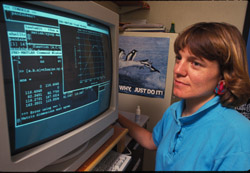
Bower uses a closed-circuit television to enlarge text to readable size. (Photo by Tom Kleindinst, Woods Hole Oceanographic Institution)
Hi! Did you ever wonder what the life of a scientist is like? Read on to find out about a typical day for me, an oceanographer at the Woods Hole Oceanographic Institution. Then click here to find out what my day is like when I’m on a research ship at sea.
8:30 AM:
I walk into my office building and make my way to my office. I can see my way there, but I use a white cane so that I don’t trip over anything that’s been left in the hallways. I’ve been legally blind for 14 years—that means I still have some vision but not enough to drive a car or recognize faces or spot a “wet floor” sign left out by the janitors.
I’ve been up since about 6:30 AM, making breakfast and helping my husband get our five-year-old daughter Sara off to kindergarten. I can’t drive, so I catch a ride to work with my husband. When he’s not around, I take a taxi or a bus.
8:35 AM:
First thing to do:check e-mail! Since I can’t see the text on a normal computer screen, I use a computer screen reader to check my messages and write responses. It reads the text out loud to me as I go. Click here to see more about the tools I use to help me work.
I check in with my assistant to see if the plane tickets have arrived yet. In two weeks I’ll be leading a research cruise on the R/V Knorr, a 300-foot ship operated by the Woods Hole Oceanographic Institution. We will travel from Cape Cod north toward Greenland. On the way, we will launch scientific instruments to measure some warm currents that flow there. Then my team of technicians and I will fly home from Greenland. The whole trip will take about 12 days.
As the trip gets closer, I’m feeling more and more excited. My favorite part of my job is going to sea on the research ships. I do this about every other year.
9:30 AM:
I pick up my cane and find my way to the next building, where the chief technician, Jim Valdes, is assembling the sensors and floats that we will launch during the cruise. We have worked together for many years as a team. I figure out what kind of measurements we want to make in the ocean, and Jim designs and builds the equipment we need to make the measurements. The kind of scientific instruments we use are usually one-of-a-kind, invented specifically to measure currents or ocean temperature in ways that have never been tried before. It’s very exciting, but a little scary too! We can never be 100% sure that everything will work as planned.
10:30 AM:
Back to my office to send more e-mail and make some phone calls. I e-mail the captain of the Knorr, Kent Sheasley. Right now he is on the Knorr with another oceanographer, but he still gets e-mail by satellite. I ask him if all our plans are in place for my cruise. I also remind him that I’m visually impaired. It’s important for him to know this, so that we can work together to keep everything extra safe.
Next, I phone Kate, a teacher from the Perkins School for the Blind, who will be going on the cruise to learn more about oceanography and bring that experience back to her students. We talk about when we will make phone calls from the ship to the classroom and some science projects we will do for the students while we are on the cruise.
11:30 AM:
Another scientist stops by my office to tell me about her measurements of ocean currents off the coast of Canada. The currents were much stronger than anyone expected, and some of her sensors were swept away. She is disappointed, but is preparing to try again with stronger materials.
12:00 PM:
Ah, lunch time! I grab a sandwich at the cafeteria, then walk across campus to an exercise class. After sitting in the office most of the morning, it feels good to stretch and move a bit.
1:00 PM:
Back to my office to grab my laptop and then off to a classroom where I give a lecture on oceanography to about 15 graduate students. To give a lecture, I prepare the material ahead of time and make it into a Powerpoint presentation. Then I use the screen magnification software on my laptop, called “ZoomText”, to give the lecture.
I really like teaching. It gives me a chance to share my enthusiasm for oceanography with others.
2:30 PM:
Finally, back to my office to spend the rest of the day working on the data from my last project. I use my computer to make pictures or plots of the data that help me figure out the ocean current patterns. Later, I will write a report on what I found out, for other oceanographers to read. They will learn something new from my report and then we will all have a better understanding of how the ocean works. That’s my goal!
5:00 PM:
I take a shuttle bus to the nearby town of Woods Hole Village and meet my husband and Sara at Sara’s after-school program. We all ride home together for dinner. I play Junior Monopoly with Sara (I roll the dice and she moves my piece around the game board), then there are bed time stories and Sara goes to bed.
9:00 PM:
I sit down at my home computer to read more e-mail and read a report written by another scientist. Being an oceanographer is a little like having your own business.

